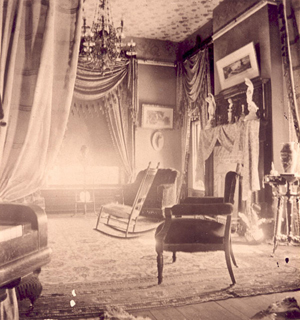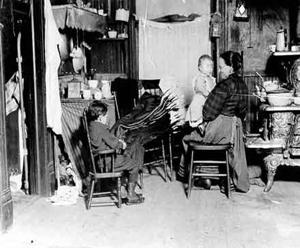Prairie Domesticity

"Character in Furniture" was Peattie's straightforward title for her column of December 17, 1893. But those three simple words are misleading in that they seem to connote the everyday, even the mundane, and Peattie's discussion of "a few of the drawing rooms around Omaha," is neither of these. [1] Lovely in its rich detail and seen through the writer's trained, journalistic eye, the piece is revealing of much more than furniture. The rooms described in her article-as her title hints-are like display cases for the characters, challenges, hopes, and limitations of the women to whom they belonged. Peattie saw the rooms when they stood empty of people, yet clearly perceived within them the essence of what it meant to be a woman living in Omaha in the 1890s on the edge of civilized, American society. "The interior of rooms furnish a study only second in interest to that of humanity itself," confessed Peattie. "Some unhappy women are forced to live in rooms which are in no way an expression of themselves, and against which they constantly revolt. But, all things being equal, you know a woman by her carpet." [2]
Peattie's evaluation of drawing rooms highlights themes common to women's lives of the era. Nostalgia for refinement and culture, the responsibility of raising and educating children, the desire to create a comfortable home, and the wish to define oneself within the new West are palpable accoutrements within the spaces. The chief interests and occupations of these homes' creators, when viewed side by side, form a mural of plains women's lives. The drawing room of an elderly matron and traveler possessed of classic style and refined taste becomes clear to the reader via Peattie's description of her floor covering: the rug was royal blue in the center, like "a heaven," and possessed "a border as intricate, as splendid as the cashmere shawl." [3] Along these same lines, the room of a "young beautiful lady" seemed spun from fairies' fabrics: "nothing old here, nothing with a history. . . all as new, as delicate of tint, as soothing to the eye as a clear dawn in winter." Of "a common woman" Peattie writes,
There are spots on the carpet, and sometimes there is even a ring for marbles marked with chalk on the hall floor. The sofa is not so remarkable for its upholstering as for its springs, which are highly regarded by certain members of the family, who play they are riding on the ocean, and who bounce up and down on them. No repose about this room, certainly–no elegance–not even the display of good taste. They people in it have never traveled. They have not collected anything–except human souls. And these they cannot keep in a cabinet. [4]
The "collecting of human souls," with its accompanying physical and mental stress and material disorder, Peattie knew, was nearer to the experience of most Nebraskan women than were Dresden figures or intricately turned cabinet legs. Factors such as gender imbalances and special land incentives for married couples worked to the advantage of young ladies desiring matrimony. Once wed, the societal expectation was that women would reproduce "with great regularity." [5] In general, birthrates actually decreased over the course of the nineteenth century: in 1800 Caucasian women bore 7.04 children before they reached menopause, and 4.24 in 1880. [6] Studies of agricultural regions, however, show that within farming families, a child was usually born every two to three years; families of "ten, twelve, even fourteen children were common on the prairie." [7]

The majority of women struggled to care for their little ones while also running the household and in some cases working on the farm. Mathilda Paul wrote, "I done all my washing by hand rubbing every garment, and often stood on one foot while rubbing and rocking the baby's cradle with the other foot." [8] "Women did not forsake the ideals of domesticity and femininity when they relocated to the prairie," writes Glenda Riley. "Instead they attempted to transplant their known ways and lifestyles to new land. Rather than leave behind aspects of life they regarded as civilized, they tried to recreate them." [9] However, nineteenth century domestic standards were difficult to achieve on the prairie, where physical necessities took precedence over embroidered doilies for the parlor.
In May, 1892, Peattie described the main goal of those seeking " prairie domesticity" in an editorial titled, "What Makes Home Home: Some People Mistake an Aggregation of Rooms For One." She opined, "Home is a place in which to be happy. Riches cannot make a home, nor can art do so, nor intellect. It is the heart that makes a home-the whole is an emanation of the affection of some man or some woman. . .the quality that makes a home is not describable, any more than poetry is, or love, or art. But just as sure and distinct as all these things is its existence, and no sooner does a stranger enter the door of a house than he can discover whether or not that house is a home." [10]
Read Peattie's Writings
References
Alberts, Frances Jacobs, ed. Sod House Memories. 1972.
"American Heritage.com: The Zenith of Prairie Architecture, the Soddy." http://www.americanheritage.com/articles/magazine/ah/1973/5/1973_5_33.sht
Holt, Marilyn Irvin. Children of the Plains: The Nineteenth Century Experience. Chicago: Ivan R. Dee, 2003.
Jeffrey, Julie Roy. Frontier Women. New York: Hill and Wang, 1998.
Peattie, Elia. "A Word With the Women." Omaha World-Herald. 5/1/95: 8.
–. The Story of America-Containing the Romantic Incidents of history, from the Discovery of America to the Present Time. Chicago: R.S. King Publishing Company, 1889.
–. "Was Not A Partisan Fight." Omaha World-Herald. 11/11/94: 10.
–. "Where Are the Children? A Lay Sermon Suggested by Chief Seavey to Colonel Hogeland." 3/20/92: 10.
White, John. Git Along, Little Dogies: Songs and Songmakers of the American West. Chicago: Board of Trustees of the University of Illinois, 1975.
Illustrations
"Interior of an affluent home, the Pratt/Campbell residence, circa 1890." Wichita Photo Archives: 1890s. http://www.wichitaphotos.org/searchresults.asp?yr=1890s&offset=10.
"Interior of a pioneer home." Home-Community Visits during an Era of Reform (1870-1920 ECRP website. http://ecrp.uiuc.edu/v2n1/bhavnagri/jamc1002-01.jpg.
Notes
XML: ep.owh.wom.0002.xml

